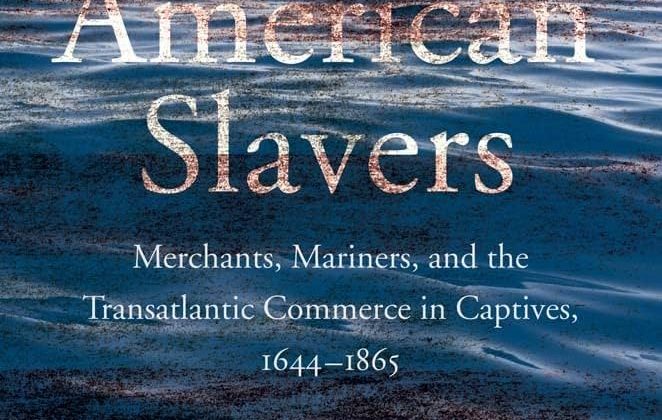

Sean M. Kelley is Professor of History at the University of Essex. This interview is based on his new book, American Slavers: Merchants, Mariners, and the Transatlantic Commerce in Captives, 1644-1865 (Yale University Press, 2023).
JF: What led you to write American Slavers?
SK: I wrote the book to fill a major gap in the literature on slavery. Many people, including a lot of very knowledgeable professional historians, assume that a book on on American slave trading must already exist, but that’s not the case. When you say the words “slave trade” to most Americans, they very naturally think about the arrival of some 450,000 African captives in North America in the seventeenth to nineteenth centuries, and there are indeed several excellent books on this topic. Beyond academia there have been a lot of recent news stories and documentaries about the Clotilda, which arrived in Mobile, Alabama in 1860. The media has labeled the Clotilda as “the last slave ship,” which in turn has fed the perception is that the American slave trade is a twice-told tale.
But that isn’t the case, and the Clotilda is a good illustration of the problem. The Clotilda was the last vessel to carry enslaved Africans to North America, but another vessel, the Mariquita, which was captured by the British in 1863, was the last known American ship to carry captives. Like most American slave ships of that era, the Mariquita was headed for Cuba, not the U.S. That distinction has been the source of much confusion, which continues to the present day. Historically, most Africans arriving in North America came aboard British ships and arrived in Southern ports, what I refer to in the book as the “ships coming in” iteration of the American slave trade. American vessels, by contrast, usually sailed from Northern ports and carried most of their captives to the Caribbean, a process I refer to as “ships going out.” A minority of American vessels (like the Clotilda) did transport captives to North America, but for most of the two-hundred year period under examination, these were separate trades. American Slavers is the first comprehensive, book-length treatment of the “ships going out” slave trade, or the participation of American merchants and mariners in the transportation of enslaved Africans to a variety of destinations, mostly to the Caribbean but also to the U.S. and South America.
JF: In 2 sentences, what is the argument of American Slavers?
SK: The book argues that the “ships going out” slave trade was a major, if neglected, chapter in the larger history of American slavery. Americans participated in the transatlantic slave trade for over two centuries, but that involvement fluctuated and was marked by a series of reconfigurations.
JF: Why do we need to read American Slavers?
SK: It’s important to read this book because it forces us to rethink the larger history of American slavery. Specifically, it asks us to grapple with the fact that American slavery was not confined to the boundaries of the present-day United States. American slavery extended across the globe, encompassing not just Africa and the Caribbean, but the Indian Ocean and South America, as well. And once you add slave trading to the larger narrative of American slavery, many historical commonplaces need to be rethought. Take the history of slave rebellion. Most historians will tell you that open rebellions were rare in American history and that the bloodiest revolt was Nat Turner’s, in which about sixty whites and fifty-five Blacks were killed. But these arguments need to be revised once you factor in the slave trade. There were probably about 200 rebellions aboard American slave ships, and the bloodiest, in which the rebels blew up the ship, killed about 240 people. Or look at slave sales. The largest land-based sale involved about 400 people, which is quite a lot, to be sure. But at least 48 American slave ships transported and sold that many or more captives. One ship, the Memphis, delivered 1,200 people into captivity in Cuba. Finally, focusing on the slave trade shifts the action from its traditional Southern locus to the North. So in the end, American slavery comes off as more extensive and more destructive once you account for slave trading.
JF: Tell us about the kinds of sources that you used to write this book.
SK: The book draws on a wide variety of sources, but two types stand out. The first of these is ships’ papers and letters from merchants and ship captains. Many of these were previously unexamined materials from ships that were captured by the British in the 1790s and 1800s. These materials provide very detailed, sometimes day-by-day accounts, of individual voyages. They offer a window into the complex process of slave trading and furnish excellent information on merchant networks, both in Africa and the Caribbean. The second type of source that I used consisted of narratives by Africans from the era of the slave trade. Many historians assume that narratives by Africans are very rare, and that’s true if by “narrative” you mean lengthy published autobiographies like Venture Smith’s. But if we consider shorter snippets as narratives, the number is considerably larger. For the past decade I’ve been involved in several collaborative projects that collect narratives by Africans, and we now have over 600 hundred of them. For this book, I drew on over 100 narratives from upper Guinea and about 30 from the Gold Coast for a chapter that explores the process of enslavement in Africa and transportation to the coast.
JF: What is your next project?
SK: While working on American Slavers, I became very interested in the Portuguese slave trade at Cape Verde. This might sound a bit out of left field, but for many years Cape Verde was an important stop for American ships. I had to read quite a bit about Cape Verde and found it fascinating. It’s going to be a little while before I publish anything on it, though.
JF: Thanks, Sean!